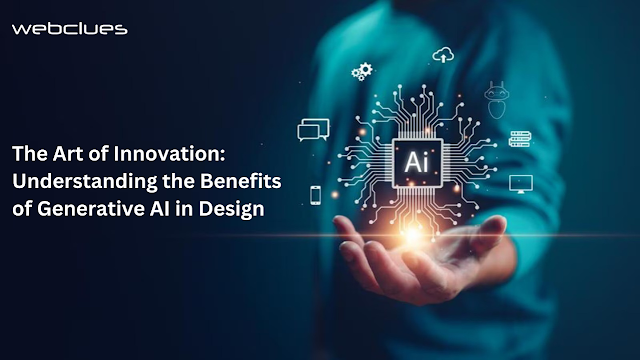The Evolution of Design and Technology:
Design has always been at the forefront of human progress, reflecting our ingenuity and shaping the way we interact with the world. From ancient cave paintings to modern architecture, the evolution of design has been intertwined with technological advancements. In recent years, the integration of AI into the design process has been a game-changer, and generative artificial intelligence stands out as a pinnacle of innovation.
What is Generative AI?
Generative artificial intelligence refers to a class of artificial intelligence systems designed to autonomously produce outputs, such as images, text, or other creative content. Unlike traditional AI, which relies on explicit programming to perform a specific task, Generative artificial intelligence leverages machine learning models to learn patterns from data and generate novel outputs. This paradigm shift has profound implications for the field of design, where creativity and innovation are paramount.
Fostering Creativity:
One of the key benefits of Generative AI in design lies in its ability to foster creativity. By analyzing vast datasets and learning from existing designs, these AI systems can generate novel and inspiring concepts that may not have been conceived through traditional methods. This augmentation of human creativity, rather than replacing it, enables designers to break free from conventional constraints and explore uncharted territories.
Generative artificial intelligence also excels in synthesizing diverse influences, allowing designers to blend styles, themes, and elements seamlessly. This synthesis of ideas can lead to the creation of truly unique and original designs that resonate with audiences in unexpected ways. As a result, designers are empowered to experiment with new forms, textures, and aesthetics, injecting a fresh vitality into their work.
Streamlining Workflows:
Efficiency is a cornerstone of any successful design process, and generative artificial intelligence contributes significantly to streamlining workflows. Traditional design tasks often involve repetitive processes, such as sketching variations, testing color schemes, or refining details. Generative artificial intelligence can automate these routine aspects, freeing up valuable time for designers to focus on more complex and strategic aspects of their work.
Furthermore, generative artificial intelligence can assist in rapid prototyping, generating multiple design iterations in a fraction of the time it would take through manual efforts. This acceleration of the design process not only enhances productivity but also allows for a more thorough exploration of design possibilities. Designers can quickly assess a wide range of options, facilitating a more informed decision-making process.
Human-AI Collaboration:
While generative artificial intelligence has the capacity to generate remarkable designs autonomously, its true potential is realized through collaboration with human designers. The synergy between human creativity and AI capabilities creates a dynamic partnership that leverages the strengths of both. Designers can guide the AI, providing it with creative direction and refining the generated outputs to align with their vision.
This collaborative approach not only enhances the quality of the final design but also provides designers with valuable insights into their own creative process. By interacting with AI-generated suggestions, designers gain a deeper understanding of design principles, enabling them to expand their skill set and stay ahead in a rapidly evolving design landscape. Hence, the benefits of Generative AI in this collaborative setting include improved creativity, efficiency, and a more profound learning experience for designers.
Pushing the Boundaries:
Generative artificial intelligence in design is not merely a tool for incremental improvement; it is a catalyst for pushing the boundaries of what is conceivable. The ability of AI to analyze vast amounts of data and identify emerging trends allows designers to stay ahead of the curve. This forward-looking approach empowers designers to anticipate evolving consumer preferences, technological advancements, and societal shifts, ensuring that their designs remain relevant and impactful.
Moreover, generative artificial intelligence encourages a mindset of experimentation and risk-taking. Designers can explore unconventional ideas and challenge preconceived notions without the fear of failure. This willingness to embrace ambiguity and ambiguity is crucial for fostering true innovation, as breakthroughs often emerge from the willingness to step into the unknown.
Ethical Considerations:
As with any technological advancement, the integration of generative artificial intelligence in design raises ethical considerations that cannot be overlooked. Issues such as bias in training data, the responsible use of AI-generated content, and the potential impact on employment within the design industry must be carefully addressed. Designers, technologists, and policymakers need to collaborate to establish ethical guidelines that ensure the responsible development and deployment of generative artificial intelligence in design.
Conclusion:
The art of innovation, as exemplified by generative artificial intelligence in design, is a testament to the boundless possibilities that arise when human creativity converges with cutting-edge technology. From fostering creativity and streamlining workflows to pushing the boundaries of what is achievable, generative AI is reshaping the design landscape in unprecedented ways. As we navigate this exciting frontier, it is crucial to approach the integration of AI with a thoughtful and ethical mindset, ensuring that the benefits of innovation are accessible to all while mitigating potential risks. The future of design is undoubtedly being shaped by the artful collaboration between human designers and the limitless potential of generative artificial intelligence. If you too are looking to explore the limitless potential of collaboration between human designers and cutting-edge technology, partner with Webclues Infotech, to experience the best Generative AI Solutions that can shape the future of design.


0 Comments